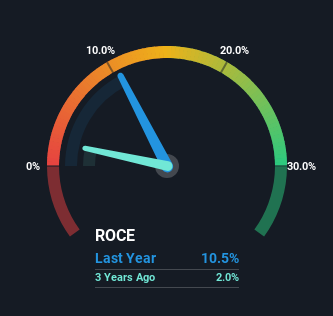- United States
- /
- Marine and Shipping
- /
- NasdaqGS:SBLK
Star Bulk Carriers (NASDAQ:SBLK) Shareholders Will Want The ROCE Trajectory To Continue
What are the early trends we should look for to identify a stock that could multiply in value over the long term? Firstly, we'd want to identify a growing return on capital employed (ROCE) and then alongside that, an ever-increasing base of capital employed. Put simply, these types of businesses are compounding machines, meaning they are continually reinvesting their earnings at ever-higher rates of return. So when we looked at Star Bulk Carriers (NASDAQ:SBLK) and its trend of ROCE, we really liked what we saw.
Understanding Return On Capital Employed (ROCE)
For those who don't know, ROCE is a measure of a company's yearly pre-tax profit (its return), relative to the capital employed in the business. To calculate this metric for Star Bulk Carriers, this is the formula:
Return on Capital Employed = Earnings Before Interest and Tax (EBIT) ÷ (Total Assets - Current Liabilities)
0.10 = US$309m ÷ (US$3.3b - US$329m) (Based on the trailing twelve months to June 2023).
Therefore, Star Bulk Carriers has an ROCE of 10%. In absolute terms, that's a pretty normal return, and it's somewhat close to the Shipping industry average of 11%.
View our latest analysis for Star Bulk Carriers

Above you can see how the current ROCE for Star Bulk Carriers compares to its prior returns on capital, but there's only so much you can tell from the past. If you're interested, you can view the analysts predictions in our free report on analyst forecasts for the company.
So How Is Star Bulk Carriers' ROCE Trending?
Star Bulk Carriers is displaying some positive trends. The data shows that returns on capital have increased substantially over the last five years to 10%. The amount of capital employed has increased too, by 43%. So we're very much inspired by what we're seeing at Star Bulk Carriers thanks to its ability to profitably reinvest capital.
The Bottom Line On Star Bulk Carriers' ROCE
In summary, it's great to see that Star Bulk Carriers can compound returns by consistently reinvesting capital at increasing rates of return, because these are some of the key ingredients of those highly sought after multi-baggers. And a remarkable 101% total return over the last five years tells us that investors are expecting more good things to come in the future. In light of that, we think it's worth looking further into this stock because if Star Bulk Carriers can keep these trends up, it could have a bright future ahead.
If you'd like to know more about Star Bulk Carriers, we've spotted 2 warning signs, and 1 of them is potentially serious.
While Star Bulk Carriers may not currently earn the highest returns, we've compiled a list of companies that currently earn more than 25% return on equity. Check out this free list here.
New: Manage All Your Stock Portfolios in One Place
We've created the ultimate portfolio companion for stock investors, and it's free.
• Connect an unlimited number of Portfolios and see your total in one currency
• Be alerted to new Warning Signs or Risks via email or mobile
• Track the Fair Value of your stocks
Have feedback on this article? Concerned about the content? Get in touch with us directly. Alternatively, email editorial-team (at) simplywallst.com.
This article by Simply Wall St is general in nature. We provide commentary based on historical data and analyst forecasts only using an unbiased methodology and our articles are not intended to be financial advice. It does not constitute a recommendation to buy or sell any stock, and does not take account of your objectives, or your financial situation. We aim to bring you long-term focused analysis driven by fundamental data. Note that our analysis may not factor in the latest price-sensitive company announcements or qualitative material. Simply Wall St has no position in any stocks mentioned.
About NasdaqGS:SBLK
Star Bulk Carriers
A shipping company, engages in the ocean transportation of dry bulk cargoes through the ownership and operation of dry bulk carrier vessels worldwide.
Adequate balance sheet and fair value.
Similar Companies
Market Insights
Community Narratives


Recently Updated Narratives

Astor Enerji will surge with a fair value of $140.43 in the next 3 years

Proximus: The State-Backed Backup Plan with 7% Gross Yield and 15% Currency Upside.


A case for for IMPACT Silver Corp (TSXV:IPT) to reach USD $4.52 (CAD $6.16) in 2026 (23 bagger in 1 year) and USD $5.76 (CAD $7.89) by 2030
Popular Narratives


MicroVision will explode future revenue by 380.37% with a vision towards success


The company that turned a verb into a global necessity and basically runs the modern internet, digital ads, smartphones, maps, and AI.



